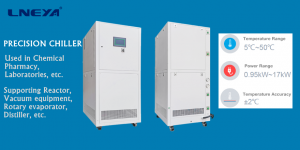Function of Evaporator in Air Cooled Chiller
The air-cooled chiller adopts the air cooling mode, which eliminates the essential cooling tower, cooling water pump and pipeline system of the cooling water system, avoids the condenser scaling and water pipe blockage in areas with poor water quality, and saves water resources. It is the most economical and simple machine for maintenance and repair in the current refrigeration equipment. The one-time investment of air-cooled chiller is slightly higher than that of water-cooled chiller, but the annual operation cost is lower than that of water-cooled chiller. The construction cost of machine room is the least among various cold and heat source systems, and the maintenance cost is about half of that of water-cooled chiller.

When the temperature of air or other fluid decreases, the pressure in the temperature sensing bag decreases. The valve port of the temperature control pilot valve is closed, and the refrigerant gas flow from the evaporator to the main regulating valve decreases. When the pressure at the top of the main piston is discharged into the suction pipe of the compressor, the main spring closes the main valve. In the air-cooled chiller system, when the evaporator pressure regulating valve is used to control the temperature, the temperature control pilot valve should be used to replace the pressure control pilot valve introduced earlier, so that the temperature of air or other fluids flowing through the evaporator can be accurately maintained at a predetermined value.
The evaporator is one of the four major components in the chiller system. The evaporator plays a role in heat dissipation in the chiller system. Connect the temperature control pilot valve with the joint of the outer pressure guide hole of the evaporator pressure regulating valve, and place the temperature sensing package of the pilot valve in the air flow or flowing medium to control its temperature. When the temperature of air or other medium increases, the pressure in the temperature sensing package increases, and the valve port of the temperature control pilot valve opens, so the evaporator pressure is transmitted to the space at the top of the main regulating valve piston through the outer pressure guide pipe, Press down the piston and open the main regulating valve. The evaporator pressure then drops to an appropriate value, which increases the temperature difference between air or other fluids and refrigerant, and improves the refrigeration capacity of the evaporator of the low-temperature chiller.
Related recommendations
-
Use and maintenance of laboratory/bioengineering temperature control system
9771. Read the equipment manual carefully before use, get familiar with the operation process and key instructions, and operate in strict accordance with the conditions specified in the manual. 2. When moving the laboratory/bioengineering temperatur...
View details -
Chemical process is inseparable from temperature control
899Chemical process is inseparable from temperature control
View details -
The principle and application of production cooling process in pharmaceutical engineering
1354Pharmaceutical engineering refers to the use of chemistry. The engineering process of transforming raw materials into drugs through a series of production processes using scientific knowledge and technological means such as biology and physi...
View details -
What are the types of industrial chillers?
1014When it comes to industrial chillers, everyone probably knows it, but is it clear to you what types of industrial chillers are divided into? What is your first reaction to industrial chillers? Industrial chiller is a kind of cooling equipment that...
View details
 LNEYA Industrial Chillers Manufacturer Supplier
LNEYA Industrial Chillers Manufacturer Supplier











